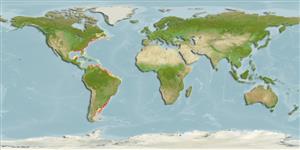Common names from other countries
Environment: milieu / climate zone / depth range / distribution range
Οικολογία
; Υφάλμυρο; εύρος βάθους 0 - 43 m (Ref. 108755). Temperate
Eastern Pacific and Western Atlantic: North America, Canada to Brazil.
Length at first maturity / Μέγεθος / Βάρος / Age
Maturity: Lm ?, range 0 - 0.55 cm Max length : 2.0 cm CW αρσενικό/απροσδιόριστο; (Ref. 79470); μεγ. αναφερόμενη ηλικία: 2.00 έτη (Ref. 109497)
Euryhaline. Prefers brackish waters, found in estuaries or quasi-freshwater lakes. Lives in muddy or sandy substrates, as well as on oyster reefs, vegetation, logs and manmade debris (Ref. 108786). Also on rubble (Ref. 97531). Omnivorous scavenger (Ref. 108786).
Life cycle: It undergoes four (4) zoeal stages and one (1) megalopa before turning into adult (Refs. 79470, 109437, 109442, 109461). Mating behavior: Precopulatory courtship ritual is common (through olfactory and tactile cues); usually indirect sperm transfer (Ref. 833). Spawning occurs from July to August in northern latitudes, April to September in mid latitudes, and April to November in southern latitudes (Ref. 109493). Females burrow in the sand to lay eggs prior to copulation, brooding takes 15-19 days (Ref. 109502).
Hill, M., R. Baker, G. Broad, P.J. Chandler, G.H. Coop, J. Ellis, D. Jones, C. Hoyland, I. Laing, M. Longshaw, N. Moore, D. Parrott, D. Pearman, C. Preston, R.M. Smith and R. Waters. 2005. (Ref. 1314)
IUCN Red List Status (Ref. 130435)
CITES status (Ref. 108899)
Not Evaluated
Not Evaluated
Human uses
| FishSource |
Εργαλεία
Διαδικτυακές πηγές
Estimates based on models
Preferred temperature
(Ref.
115969): 7.2 - 22.9, mean 14.2 (based on 234 cells).
Ελαστικότητα
Υψηλό, ελάχιστος χρόνος για διπλασιασμό πληθυσμού < 15 μήνες (K=1.28; tmax=2).
Price category
Unknown.
